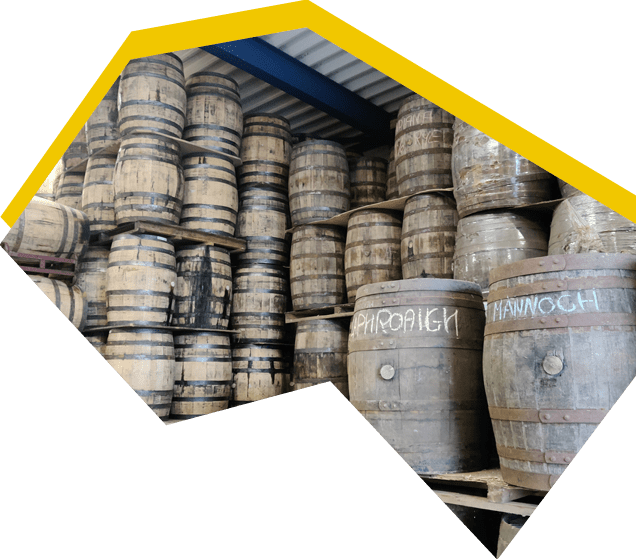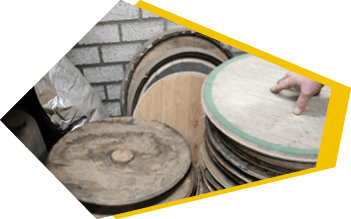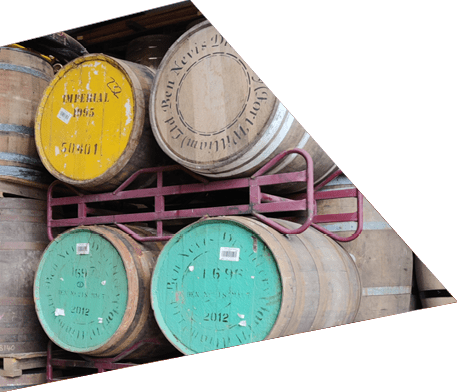
Staring at the barrel…
We spoke to founder and owner of Omtzigt Trading, Maarten Omtzigt in his warehouse surrounded by more than 1500 barrels. He is the man when it comes to barrels in the Netherlands and now the whole world! We visited him because of his special profession and to hear how he rolled into the business.
How did the barrel start rolling?
The website shows that Maarten was brought in the business by the Scotsmen, but what’s the real story? “The shipyard is behind the building. I was a cabinet maker/ship carpenter and the Scotsmen came to do the hydraulics. One evening we were talking about a possible trade, so we had whisky barrels come to the Netherlands. In the beginning we used these purely for decoration such as tables tops and lids on the wall. Later Robbert Uyleman came by, he was one of the first to start putting beer in barrels on a large scale. Now we also deliver to Denmark, Finland…it goes all over the world,” says Maarten.
A barrel comes in and then what? “First the barrel goes through quality control. For this we put pressure on the barrels to see if they are airtight. If it drops, we’ll see if it needs to be restored, repurposed or destroyed. When you receive a barrel from us, you have a 2-3 week guarantee that it will remain watertight. We cannot guarantee what happens to it afterwards. For example, if it is left in the sun for too long, the wood will start to work. That is why we also have misters in the shed for the hot summers, to protect our barrels,” explains Maarten.
“I also make a taste profile, when the barrel opens I write down what I smell. I can only do this a few times a day, otherwise my scent is too much affected. When I got corona I was afraid of becoming unfit for work, I couldn’t smell for two months,” Maarten adds with a laugh. “We sometimes have deliveries with 30 different barrels, then I spend weeks mapping all of them. We often know for 98% exactly what was in the barrel, then I can get started with that as a base profile. A special barrel is a bit more difficult, I won’t find any description on Google. Often you see that the contents of a barrel is put on the lid of the barrel, only barrels are often reused and painted over. You can deduce from the thickness of the paint how often the barrel has been refilled, my nose has to discover what,” explains Maarten.

The taste of the wood
What about the taste of the barrels? “The drink and the wood provide the flavour. You have American oak and native/European oak, Spanish or French, these are the most used. You also see acacia, cherry wood and chestnut wood, but in general it’s oak. Much of the flavour of the wood comes from toasting. More than 70 years ago they discovered that if you toast/burn the inside of a barrel, beautiful vanilla notes are released, before the barrels were still blank inside,” explains Maarten.
“Sometimes the drink is of great influence. Whiskys from the islands have that peaty/salty taste. This will always dominate the next drink that goes into the barrel. For example, inland distilleries often use island barrels for this salty finish. Or they use port, sherry, calvados, muscatel or wine for slightly sweeter flavours. In addition, it is also important how long the drink is in a barrel. The longer, the more flavour soaks into the wood. It’s like a tea bag, you can use it several times, only the taste decreases over time. A barrel that can no longer be used for distillates can still be beautiful for beers, because of the taste of the liquor. Even though the taste of the wood has really gone. The barrels could be toasted again,” says Maarten.
Barrel Ageing Beers
So a somewhat older barrel remains suitable for barrel ageing beers? “Certainly. If a brewer comes up with an idea for barrel ageing, I help. What flavour profile is he looking for? What kind of cask can you achieve that with? And then the search for the right barrel begins. All over the world. Sometimes I receive something and I immediately know which brewer may be interested. To test the barrel I sand blast rejected barrels, these are like new on the outside after blasting, but the taste remains in the wood. If you leave a few of these shreds and the beer in a preserving, you will have a good idea of the end result. As far as I’m concerned, a beer has to be aged for at least 8 months to be able to call it barrel aged. Only then does the taste of the wood start to give off, before this it is mainly the beverage,” explains Maarten.
“When barrels come back from brewers, they don’t come in anymore. Literally. These barrels are placed outside to ensure that the ‘new’ barrels inside remain protected. Beer has a lower alcohol percentage and is therefore more susceptible to infections. It’s the same with wine. With 64% alcohol inside, that is different. If you preserve it well, you can leave a whisky barrel without content for six months. With low alcohol, you have to switch quickly, a maximum of two months. A brewer often leaves some beer in it. I take it out and have it distilled again and put it in a barrel myself to taste and test years later. When does the drink give off the taste, when does the wood? And a lot of people come to that tasting session.
For example, after a session I know what a sherry barrel does for an Imperial stout, which I then share with brewers in order to come up with the most beautiful beers,” Maarten says proudly.
Finishing touch
For the latest Van Moll beer we used a finish barrel, what’s that? “A finish barrel is used on average for 6-8 months to give different flavours to the drink. Pure for a different taste impulse. After their ‘defloration’, the barrels are no longer used in America (only for one year by law). In Scotland they use the barrels more often. Or they come here. For the Woodford Rerserve Double Oaked, a brand new barrel has been used for a finish, that real vanilla kick. It is a virgin barrel that has never been used for anything else, so purely for that wood taste. Then it was sold to me, after a one-time use of a year by a distiller,” says Maarten.
“Many whiskys are finished in sherry casks, so these barrels are very popular in Scotland. There is a shortage. A sherry cask is filled and emptied and refilled after 2 years, this continues for years. They leave behind the serene, grape sediment, to ensure the same flavour profile. And in that ‘syrup’ is the real taste, this often also contains the separation of the charcoal. It is very popular, the more sediment, the more expensive the barrel. If there is a layer of black at the bottom of a whisky, then it is very expensive. Often the barrel is not expensive, but the drink is. It’s the other way around with Sherry,” says Maarten.
Circular barrels
Besides selling barrels to refill you’ve expanded your business with other related elements. “Related products such as the racks that hold the barrels. I came up with a stacking system when I saw that many large barrels were kept on the floor. The height in the work area results into saving a lot in square meters,” says Maarten with a smile. “We also helped in developing a barrel park. For example in safety and suitable temperatures” adds Maarten.
“We hardly throw anything away, my stove at home burns well on unusable barrels. We also make smoking wood from the slats for smokers and bbqs. Which also includes the flavours of the drinks. The slats are dried and shredded,” explains Maarten. About this product there was a television item years ago, worth the watch (Dutch only). “We even send the steel rings back to Scotland to be reused. I also send loose slats to Spain to make the small test casks for my tasting process. Making barrels yourself is not feasible here, it’s simply too expensive. You have your countries like Romania and Spain for that.”
The Angels Share
That’s it, got everything in and out of the barrel? “Well, you also have the part of the angels. The Angels Share, which is also a great movie. It is about derailed Scottish youth who are going to fix up a church, they want to start a whisky distillery there and they are very creative with The Angels Share. The thing is, there is about 225 litres in a barrel, when it is 50 years old it will only contain 40 litres, the rest has evaporated through the wood. That is the part of the angels that evaporated alcohol, but it is still visible,” explains Maarten. “Come outside with me”.

No sooner said than done.
“We cleaned these halls at the same time, but it is already almost black due to the alcohol emissions from the barrels. You see it everywhere in Scotland, all warehouses are black from the outside,” Maarten says proudly.




